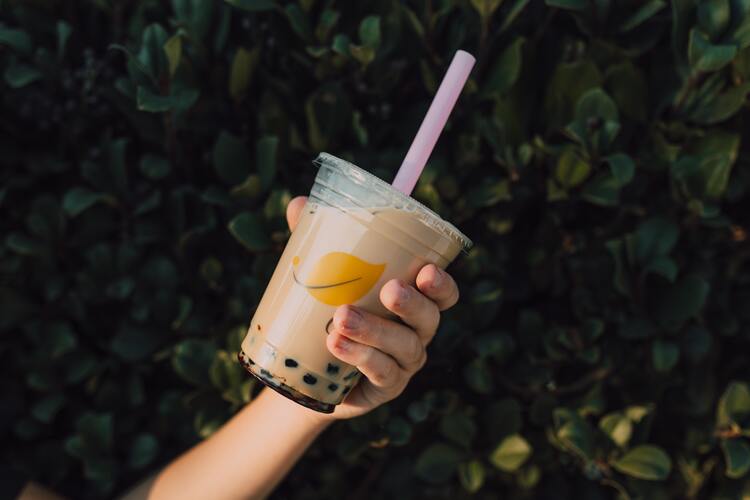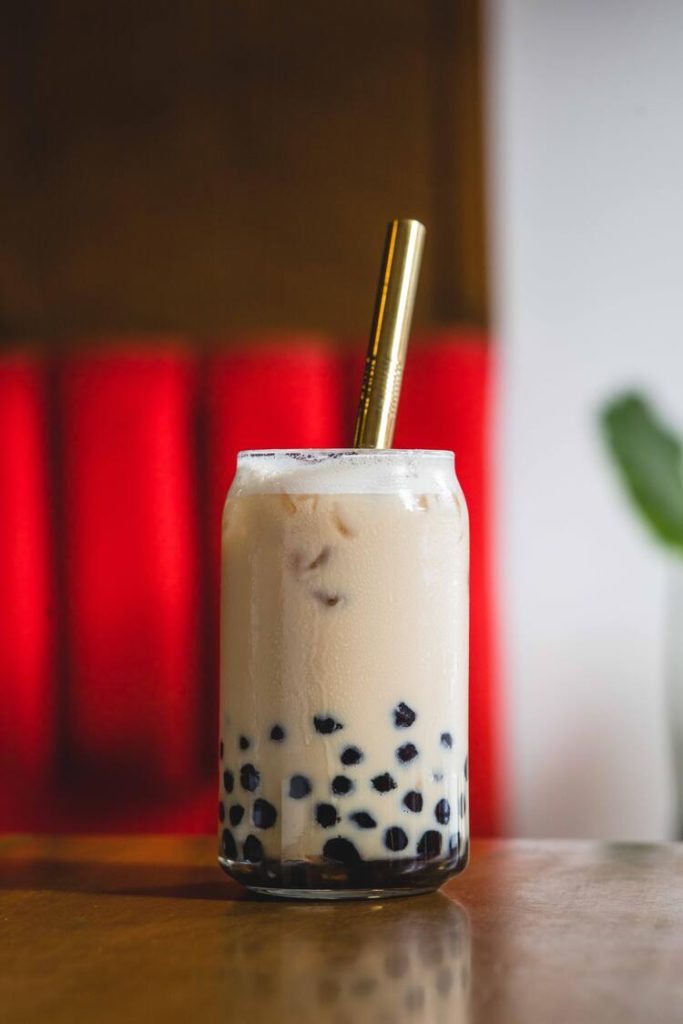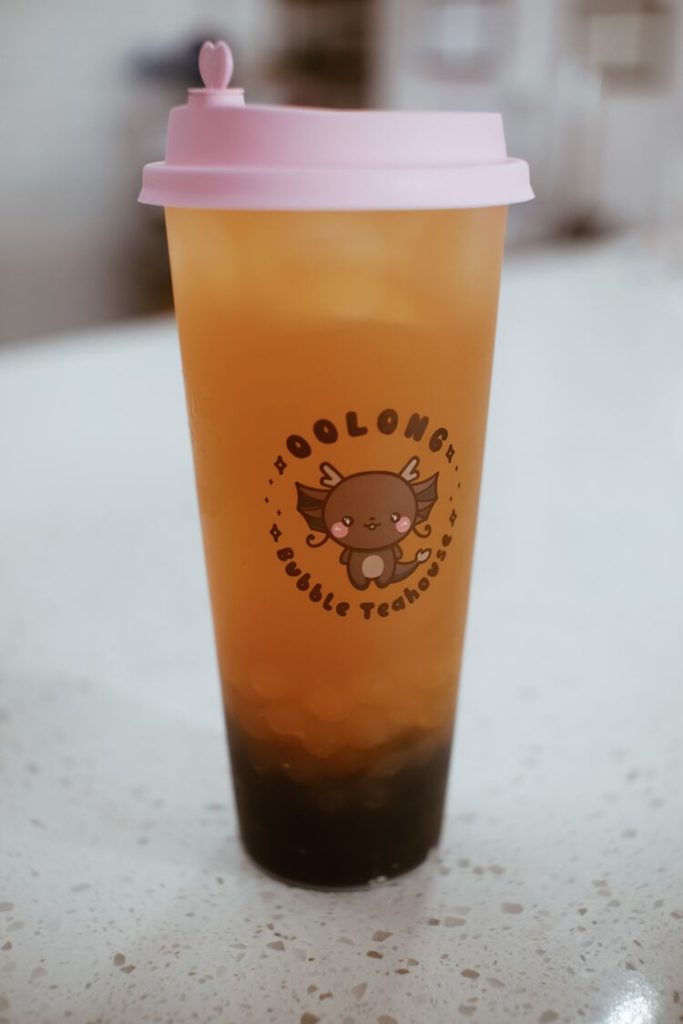Oolong milk tea is a delicious beverage you’ll want to try if you haven’t already. This unique beverage, originating from Taiwan, has a creamy, milk-like aroma and a smooth, velvety, comforting, and refreshing flavor. Made from partially fermented oolong tea leaves, it balances black tea’s robustness and green tea’s lightness.
In this article, we will discuss what sets this beverage apart. In addition, we will provide instructions on how to prepare the classic milk tea at home and some ideas on variations. Buckle up your seat belt because it will be a fun ride!
Please note: This article contains affiliate links, meaning I may earn a commission if you make a purchase by clicking a link. Of course, this comes at no extra cost to you and helps me keep offering readers solid information.

What Is Oolong Milk Tea?
Oolong milk tea is made from oolong tea leaves and milk. Oolong tea has a unique flavor and sits between green and black tea on the oxidation spectrum.
While green tea is minimally oxidized and retains its delicate, fresh taste, black tea undergoes full oxidation, resulting in a bold, robust flavor. Oolong tea, however, falls in the middle, with partial oxidation, giving it a complex and diverse taste profile.
As you may know, all types of tea come from the same plant, Camellia sinensis. The difference lies in the processing techniques, which give each tea its distinct characteristics.
History of Oolong Tea
Oolong tea has an interesting history that dates back centuries. Originating in China, oolong tea production gradually spread to Taiwan, now one of the world’s top producers. The history of oolong tea can be divided into three main periods:
- Ancient Period (10th-16th century): During this time, tea-drinking customs and tea cultivation techniques were developed in China. Different regions began producing their distinct varieties of tea.
- Ming and Qing Dynasties (1368-1912): Oolong tea gained popularity during these dynasties, and its production techniques became more refined. Oxidation and rolling techniques were introduced, leading to a wider range of oolong tea styles and flavors.
- Modern Period (1912-Present): The production of oolong tea spread to Taiwan, which developed its own unique oolong tea varieties. Today, Taiwan is known for producing high-quality, flavorful oolong teas enjoyed worldwide.
Processing
Oolong tea processing involves several steps crucial to its unique flavor and aroma.
- Withering: The freshly harvested tea leaves are spread out to wither for several hours to reduce the moisture content and make the leaves pliable.
- Tossing: The withered leaves are then gently tossed and shaken to bruise the edges of the leaves.
- Oxidation: The degree of oxidation is carefully controlled by the tea maker, who will repeatedly toss and shake the leaves to ensure an even oxidation level.
- Firing: Once the desired oxidation level has been achieved, the leaves are heated to stop the oxidation process. This step also helps to stabilize the flavor and aroma of the tea.
- Rolling: The leaves are then rolled into tight balls, which helps to release more of the tea’s natural oils and flavor.
- Drying: The rolled leaves are then dried, which removes any remaining moisture and locks in the flavor and aroma.
The processing of oolong tea requires great skill and attention to detail, as the degree of oxidation and the timing of each step can greatly impact the final product. The resulting tea can have various flavors and aromas, from floral and fruity to woody and smoky, depending on the specific variety of oolong tea and the processing techniques used.

Oolong Milk Tea Ingredients
Tea Base
To make the perfect Oolong Milk Tea, starting with the right kind of Oolong tea is crucial. The most common Oolong teas for milk tea are loose-leaf red robe tea and traditional Tie Guan Yin (Iron Goddess of Mercy), Dong, Ding, Pouchong, Alishan, and Jin Xuan.
Here are some tips for selecting the best Oolong tea:
- Choose high-quality, loose-leaf tea for the best flavor and aroma.
- Determine the level of fermentation and flavor preference, from light and floral to robust and earthy.
- Purchase from a reputable tea store or online vendor to ensure authenticity and freshness.
Milk and Sweeteners
When it comes to adding creaminess to the beverage, the traditional choice is whole milk since it provides a rich and satisfying taste. However, use your preferred milk or milk substitutes like soy or almond milk. For your sweeteners, you can use sugar or brown sugar to enhance the tea’s depth and sweetness.
Tapioca Pearls
Tapioca pearls, or “boba,” are a classic Oolong Milk Tea ingredient. Black tapioca pearls, made from tapioca starch, are popular for their chewy texture and slightly sweet taste. Here’s how to prepare them:
- Boil a pot of water (at least 6 cups for every 1 cup of tapioca pearls).
- Add the tapioca pearls to the boiling water and cook for 25-30 minutes.
- Remove from heat, cover, and let sit for 25-30 minutes.
- Drain the pearls and rinse with cold water.
- Place the cooked pearls in a bowl and mix them with some brown sugar or caramel syrup. This is an optional step (and more geared toward those with a sweet tooth).
Keep in mind brands are selling “instant” tapioca pearls. These are placed in a microwave and ready in minutes. You may want to experiment with those to decrease preparation time.
Toppings
You can add variety to your Oolong Milk Tea with a selection of toppings. Ice cubes are a must for a cold and refreshing drink. As you desire, you can also add exciting flavors like caramel sauce drizzled on top. We will provide plenty of additional ideas in the “Variations” section below.
How to Make Oolong Milk Tea
We have discussed the ingredients needed to prepare this milk tea. Below you will find exact instructions on how to put everything together.
Preparing the Ingredients
First, gather the ingredients in these proportions:
- 1 tablespoon Oolong tea
- 1 1/2 cups water
- 1/2 cup milk (whole milk, almond milk, or any preferred milk substitute)
- 1/2 cup cooked tapioca pearls (follow the instructions we have provided in the previous section or follow the package instructions)
- 1 tablespoon sugar or preferred sweetener (optional)
Oolong Milk Tea Recipe
Follow these simple steps to make your delicious Oolong Milk Tea:
- Boil water and let it cool for about 1 minute (water temperature should be around 190-200°F, or 90-95°C).
- Steep your Oolong tea in the hot water for 3-5 minutes, depending on how strong you want the tea.
- Once the tea has finished steeping, remove the tea leaves with a strainer.
- Let the tea cool down to room temperature.
- In a shaker or blender, combine the cooled oolong tea, milk, and sugar or sweetener. Shake or blend until well combined.
- Fill a tall glass with ice cubes and pour the oolong tea mixture over the ice.
- Add the cooked tapioca pearls to the glass, using a spoon to mix them into the tea.
- Finally, taste your Oolong Milk Tea and adjust the sweetness and milk ratio as desired. Enjoy!

Popular Oolong Milk Tea Variations
If you enjoy Oolong milk tea, then you’ll be delighted to explore some popular variations of this tasty beverage. Here are a few options you may want to try the next time you crave this milk tea fix:
Taro Oolong Milk Tea
This variation adds taro powder or taro syrup to the oolong milk tea to give it a nutty, slightly sweet flavor and a purple hue. The taro can also be blended with ice to make a slushy consistency. You can prepare this recipe with oolong tea instead of black tea.
Brown Sugar Oolong Milk Tea
Brown sugar is used as a sweetener in this variation, giving the tea a rich, caramelized flavor. The tea is often topped with brown sugar pearls or brown sugar jelly to enhance the sweetness. You can prepare this recipe with oolong tea instead of black tea.
Matcha Oolong Milk Tea
This variation combines oolong tea with matcha powder, resulting in a unique blend of flavors. The tea can be sweetened with honey or sugar, and can also be topped with matcha powder or whipped cream for added texture.
Lavender Oolong Milk Tea
Dried lavender buds or lavender syrup can be added to the milk tea for a floral, aromatic flavor. The tea is often sweetened with honey and topped with whipped cream or lavender jelly.
Toppings Galore
Besides boba, feel free to experiment with other tantalizing toppings. Some popular options include:
- Fruit jelly: Various flavors of fruit jelly, such as mango or lychee, can add a refreshing twist to your Oolong milk tea.
- Grass jelly: Cut into small cubes, grass jelly brings a subtle herbal flavor and an enjoyable texture to your beverage.
- Pudding: A touch of silky pudding offers a smooth, creamy addition to your milk tea.
- Chia seeds: For a healthy boost, sprinkle nutrient-packed chia seeds.
These are just a few examples of the many variations of oolong milk tea. The possibilities are endless, and tea shops often offer customized blends and toppings to suit individual preferences.

Food Pairings
Oolong milk tea is a delicious and versatile beverage that pairs well with a wide variety of foods. Here are some suggestions for food pairings:
Dim Sum
Oolong milk tea is the perfect beverage to pair with dim sum, a type of Cantonese cuisine that features small, bite-sized dishes like dumplings, bao, and steamed buns. The tea’s bold flavor can balance the richness of the dim sum, while the milk provides a creamy contrast.
Spicy Foods
The creamy milk in the beverage can help cool down the heat of spicy foods, making it a great pairing for dishes like curry, stir-fry, and spicy noodles. Also, it can help soothe any lingering spiciness on the palate.
Desserts
Oolong milk tea can be a great complement to desserts, especially those with bold, rich flavors like chocolate, caramel, and matcha. Try pairing the milk tea with a slice of chocolate cake, a bowl of ice cream, or a matcha parfait for a delicious and satisfying treat.
Salty Snacks
The milk tea can help balance the saltiness of snacks like popcorn, chips, and pretzels. It can also provide contrast and enhancement of flavors.
Seafood
Oolong milk tea can be a refreshing pairing for seafood dishes like sushi, sashimi, and seafood salads. The tea’s subtle, floral flavor can complement the delicate flavors of the seafood, while the milk can help round out the overall taste.
Health Benefits of Oolong Milk Tea
Here are some of the health benefits of Oolong tea:
May Aid in Weight Loss
Oolong tea contains compounds called polyphenols, which have been shown to boost metabolism and promote fat burning. Some studies suggest that regular consumption of oolong tea may help with weight management.
Could Improve Heart Health
Oolong tea has been linked to a lower risk of heart disease, as it may help reduce blood pressure and lower cholesterol levels. The antioxidants in oolong tea may also help protect against oxidative stress and inflammation, which can contribute to heart disease.
May Boost Brain Function
Oolong tea contains caffeine, which can improve alertness and concentration. It also contains theanine, an amino acid that may promote relaxation and reduce anxiety.
Oolong tea generally has less caffeine than black tea (which in general is a popular option for milk tea), which makes it a suitable choice for those who are sensitive to caffeine.
Here’s a comparison of the caffeine content in different types of tea:
- Green Tea – 28 – 48 mg caffeine per 8 oz cup
- Black Tea – 47 – 64 mg caffeine per 8 oz cup
- Oolong Tea – 37 – 55 mg caffeine per 8 oz cup
Could Support Bone Health
Some studies suggest that regular consumption of oolong tea may help improve bone density and reduce the risk of osteoporosis. The polyphenols in oolong tea may also help protect against bone loss.
May Have Anti-Cancer Properties
Oolong tea contains antioxidants that may help protect against DNA damage and cell mutations, which can contribute to the development of cancer. Some studies have also shown that regular consumption of oolong tea may help reduce the risk of certain types of cancer, including breast and ovarian cancer.
Oolong Tea Buying Recommendations
We always recommend buying your tea from a local, specialized tea provider. If this is not a possibility, here are some recommendations from an online retailer.
Goartea Premium Chinese Oolong Tea

Yan Hou Tang Jin Xuan Milk Oolong Tea Loose Leaf Organic


Find below some recommendations with respect to toppings for your milk tea.


Buy on Amazon now (these are a quick cook option, they are already flavored/sweetened)


Oolong milk tea has become a beloved beverage around the globe, and understanding its background can enhance your appreciation of this delightful drink. Enjoy your cup of oolong milk tea, knowing it has a rich history and a distinctive place in the world of teas.
Have you tried oolong milk tea?